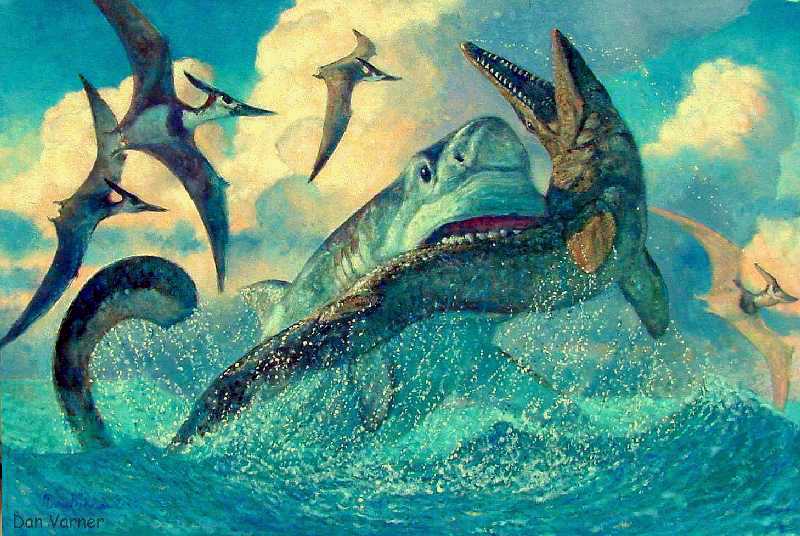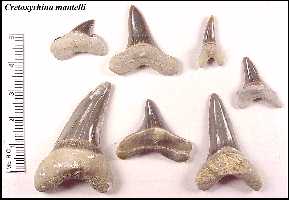
A Moment in Time
Copyright © 2000-2009 by Mike Everhart
Revised 03/26/2009
May 12, 2003 - Translated into French ![]()
by Jean-Michel Benoit (Click on flag)
LEFT: "Cretoxyrhina attack" Used with permission of Dan Varner; Copyright © Dan Varner
The young adult mosasaur struggled wearily as it swam slowly just below the calm surface of the warm, shallow sea. It was the peak of the yearly breeding season. A chance encounter with an enraged and much larger bull mosasaur earlier that day had left his left front flipper crippled and useless. The six meter long marine reptile kept rolling over on its left side because the damaged flipper no longer provided the necessary steerage to keep him upright. Trying to swim without the use of the flipper had tired the creature to the point of exhaustion and had also attracted the attention of other scavengers in the area. Even surfacing to breathe was difficult and his efforts to raise his head above the the water were noisy.
Alhough the bleeding from the superficial wounds on his left flipper had stopped hours ago, a swarm of small Squalicorax sharks still cruised warily in circles around the struggling mosasaur, occasionally darting in closer as if sizing up the best opportunity to attack. The largest of these sharks was less than a third of the length of the mosasaur and normally would not have represented more than an annoyance. In fact, the mosasaur had killed and eaten many such sharks over the years.
Now the tables had turned and the wounded mosasaur was the prey instead of the predator. There was no place to hide in the middle of the Western Interior Sea and there was no protection to be had from others of his own kind.
From far outside the circle of scavenger sharks, another, much larger Ginsu shark moved relentlessly toward the mosasaur. The shark’s acutely tuned senses had detected the thrashing sounds made by the wounded reptile from more than a mile away and alerted the shark to the potential feeding opportunity. Almost as long as the mosasaur and more than twice as heavy, the giant shark scattered the smaller scavengers in its path as it approached from below the mosasaur at high speed. The open jaws of the shark hit the mosasaur on the right side, just behind the rib cage, and the impact lifted the wounded animal almost completely out of the water. When the massive jaws closed, two rows of razor sharp, five centimeter (2 inch) teeth sliced out a dinner plate sized chunk of skin, muscle and intestines from the mosasaur, opening a bloody and very fatal wound.
Then, before the wounded reptile could even react to the first bite, the jaws closed again, this time across the 7 cm (3 inch) wide spinal column. The sharp teeth sliced easily through the mosasaur's strong muscle and dense vertebrae, severing the spinal cord and major blood vessels. As the teeth were driven through the 5 cm (2 inch) thick vertebral centra, the tips of several were broken off in the bone. The water quickly turned blood-red as the mosasaur thrashed briefly in its death throes, it's body cut almost completely in two by the Ginsu shark’s terrible bite.
Then, as the Ginsu shark opened and closed its mouth rapidly to swallow the large chunks of flesh and bone, the other scavengers flashed into the blood filled waters and attacked the carcass of the dead mosasaur. The big shark started to move back into the feeding frenzy, and then abruptly changed directions, swimming slowly away from the swarming scavengers. Its immediate hunger satisfied, the shark turned its attention away from the battle over the remains of the mosasaur, and resumed its westward path through the warm waters. Two hours later, the giant Ginsu shark opened its mouth and regurgitated a thirty cm (12 inch) long chunk of indigestible mosasaur vertebrae.
 |
LEFT: The teeth of the Ginsu shark (Cretoxyrhina mantelli). |
 |
At left is a paleontologist's sketch (Shimada, 1995) of what Cretoxyrhina
may have looked like. We are still discovering well-preserved remains of this
shark (See 2002 discovery HERE). Based on this recent find, I
now believe that the maximum length of these sharks may be somewhat larger than 4.5 to 5.5
meters, possibly as much as 7 m, depending upon the length and shape of the caudal fin
(tail). More about the Ginsu shark: Cretoxyrhina mantelli - The Ginsu Shark Shark Bites: Parts is parts and pieces is pieces Another fictional story about this shark: |
The five vertebrae, all initially damaged by the shark's bite and now severely eroded by its stomach acid, were still held together by tough ligaments. They sank rapidly through 100 meters (325 feet) of water and landed in darkness on the soft chalky mud of the sea bottom. The speed of the impact partially buried the vertebrae in the gray mud and discouraged further attack by smaller scavengers. Before long, the remains had completely disappeared beneath the surface. There they would be entombed as fossils for almost 85 million years. Eventually, hundreds of meters of chalky mud and black shale would cover the bones before the land rose and the shallow ocean receded hundreds of kilometers to the shores of the present Gulf of Mexico.
Over millions of years, these soft sediments were compressed into layers of soft rock. Then they were uplifted more than a kilometer (0.6 mile) above sea level as a result of the formation of the Rocky Mountains. Then, even as the uplifting occurred, more than 60 million years of weathering and erosion gradually wore away all of the shale and most of the chalk over the vertebrae and exposed them to the light of day.
Fast forward in time to 1995 when a sharp-eyed, bipedal mammal walking across arid remains of the eroded sea bottom happened to chance upon the lumps of reddish brown bone while walking across an exposure of gray chalk. Recognizing them as the vertebrae of a large mosasaur, the human took out a sharp instrument and a brush and carefully exposed the rest of the 30 cm (12 inch) long specimen. Disappointment soon clouded the human’s face as he searched in vain along the chalk exposure. Where was the rest of the mosasaur? Five vertebrae was not much of a consolation when you were hoping to find a six meter long marine reptile. Giving up, he marked and bagged each vertebra, put them in his pack and resumed his search. It was more than a week later when he cleaned up the specimen that he saw the bite marks and embedded sharks' teeth and realized what he had found.
In talking to other paleontologists, it soon became evident that no one had ever documented this kind of evidence of predation or scavenging on mosasaurs by the large Cretaceous shark, Cretoxyrhina mantelli. This shark is represented in the fossil record by numerous shed teeth and several mummies that include teeth, vertebrae and preserved tissues such as cartilage and dermal scales. In life, the shark was comparable in size and attitude to the Great White shark depicted in the movie, "Jaws", and was certainly capable of eating anything that it wanted.
The specimen (VP 13283-5) was donated to the Sternberg Museum at Fort Hays State University, Hays, Kansas in 1995. A drawing and description of the specimen was included in Shimada (1997) and Everhart (1999). It went on public display (photo at right, below) when the new Sternberg Museum of Natural History was opened, as an example of the interaction between species of predators living in the Western Interior Sea. The three pictures below-left are of the prepared specimen, showing the bite marks and the embedded tooth. The picture (below-right) shows the specimen as exhibited.
 |
 |
 |
 |
The specimen has been cited in several journals:
Everhart, M. J. 1999. Evidence of feeding on mosasaurs by the late Cretaceous lamniform shark, Cretoxyrhina mantelli. Jour. Vert. Paleon. 17(suppl. to 3):43A-44A.
Everhart, M. J. 2004. Plesiosaurs as the food of mosasaurs; new data on the stomach contents of a Tylosaurus proriger (Squamata; Mosasauridae) from the Niobrara Formation of western Kansas. The Mosasaur 7:41-46.
Everhart, M. J., P. A. Everhart and K. Shimada. 1995. New specimen of shark bitten mosasaur vertebrae from the Smoky Hill Chalk (upper Cretaceous) in western Kansas. Kansas Academy of Science, Transactions 14:(Abstracts)19.
Schwimmer, D. R., J. D. Stewart and G. D. Williams. 1997. Scavenging by sharks of the genus Squalicorax in the Late Cretaceous of North America. Palaios 12(1):71-83.
Shimada, K. 1997. Paleoecological relationships of the late Cretaceous lamniform shark, Cretoxyrhina mantelli (Agassiz). Journal of Paleontology 71(5):926-933.
 |
Exposed late Cretaceous sea floor (Smoky Hill Chalk) in Gove County, Kansas, where the shark bitten mosasaur vertebrae were discovered in January, 1995. |
"Shark Attack" Kansas Academy of Sciences Abstract and additional pictures
Credits: The Cretoxyrhina mantelli drawings were adapted from Kenshu Shimada, 1994. Paleobiology of the Late Cretaceous Shark, Cretoxyrhina mantelli. Unpub. Masters Thesis, Fort Hays State University.